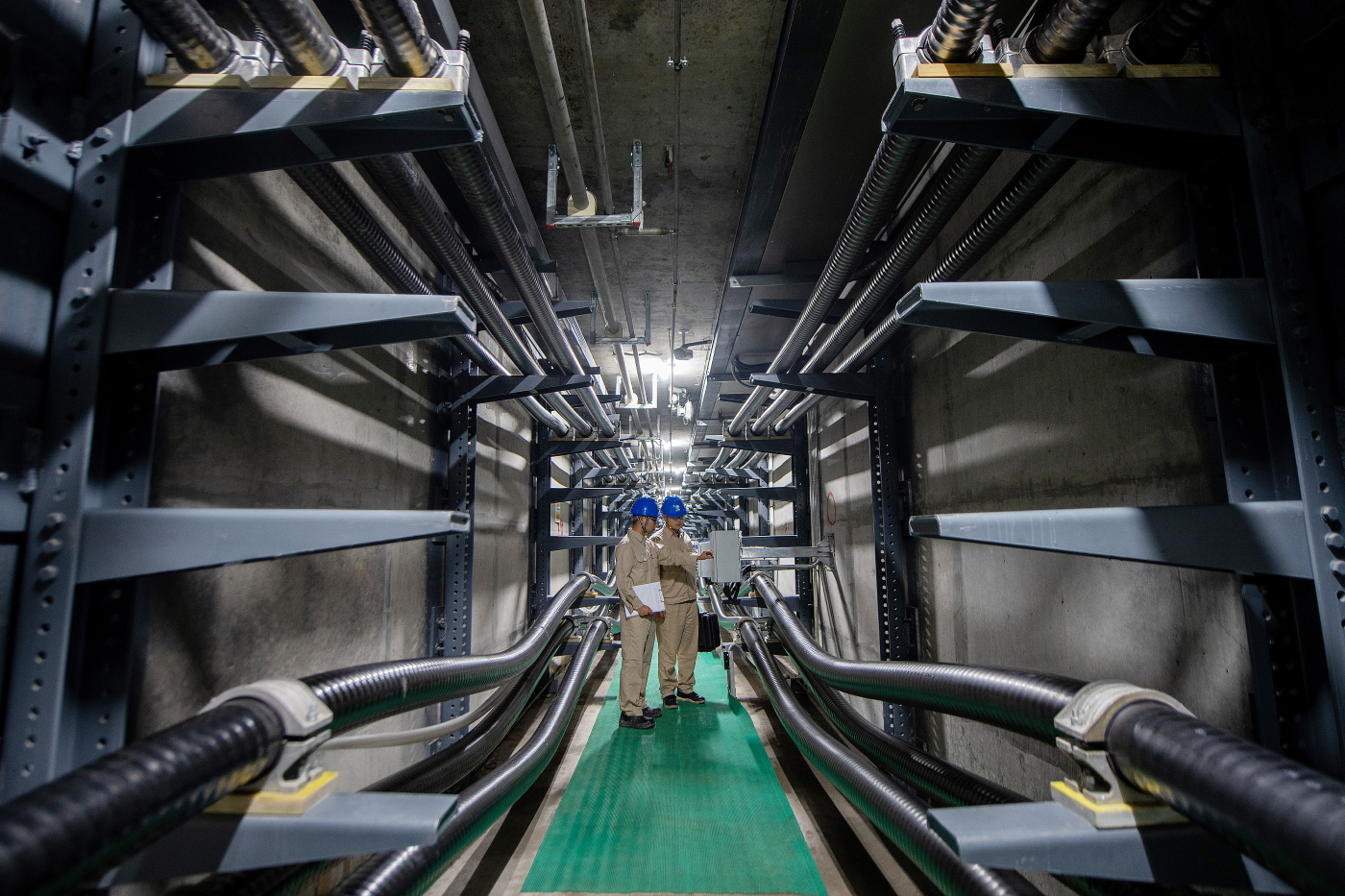

Газар доорхи кабелийн хэрэгжилт нь маш чухал бөгөөд хялбар бөгөөд аюулгүй юм.
Хятадын олон хотод, ялангуяа зарим томоохон хотууд эсвэл шинэ хот суурин газруудад, цахилгаан цамхагууд, мөн утаснууд нь үл үзэгдэх болно. Гэхдээ олон мянган айл өрх цахилгаан эрчим хүчийг хэвийн хэмжээнд ашиглах боломжтой. Энэ нь голчлон цахилгаан дамжуулалтыг дамжуулж, цахилгаан эрчим хүч дамжуулах.
Газар доорхи кабель нь цахилгаан дамжуулах чухал арга юм, газар доорхи суваг байгуулах, кабелийг тасралтгүй цахилгаан тэжээл авах.
Сүүлийн жилүүдэд, Газар доорхи цахилгаан кабелийг хянах чадвар нь илүү хүчтэй, хүчтэй болжээ.
Болон шинэ технологийг байнга нэвтрүүлж, сурталчилж байна, Газар доорхи кабелийн ерөнхий боловсролд хатуу суурь тавигдсан.
Хятад эдийн засгийн хөгжил, хотжилтыг хурдасгахад, Цахилгаан эрчим хүчний байгууламжийн хоорондох зөрчилдөөн.
Хот суурин газар улам их, илүү нэр хүндтэй болж байна. Хотын оршин суугчдын аюулгүй байдлын аюулгүй байдлыг хангах, цэвэр, үзэсгэлэнтэй хотыг хадгалах.
Үүнийг багасгах шаардлагатай Дамжуулах шугамууд хотод, тэдгээрийг газар доор тавь, газар доорхи цахилгаан кабелийг хөгжүүлэх.
Статистикийн дагуу, дэлхийн зарим орчин үеийн хотууд, жишээ нь berlin, Copenhagen, гэх мэт., газар доорхи цахилгаан дамжуулах аргыг үрчилж авсан 70%.
Одоогоор, Хятад нь мөн газар дээр нь overhead offore шугамыг барих хурдыг хурдасгаж байна, Газар доорхи кабелийн төсөл, газар доорхи нэгдсэн коридорууд.
Одоогийн байдлаар, Бусад олон хөгжсөн орнуудад, кабель суурин газар бараг л байсан 100%.
Учир нь кабель нь агаарт өртдөг, салхи, бороо, Кабелийн хөгшрөлтөд амархан тохиолддог.
Тусгаарлагч давхарга нь агаар мандал дахь хүчиллэг, шүлтлэгийн кабель, шүлтлэгийн кабель нь мөн хэт их хэмжээний далан кабель нь маш их аюултай аюул юм.
Тиймээс, гадаа цахилгаан кабелийг авах нь зайлшгүй шаардлагатай бөгөөд маш чухал юм.
Гэхдээ Газар доорхи цахилгаан утас нь илүү өндөр аюулгүй байдалтай хэвтэж буй арга юм.
Ихэвчлэн, Хэт их шугамыг зөвхөн өөр цамхагт засах боломжтой.
Гэхдээ газар доорх газрын кабелийн шугамыг булшлах нь олон хэлхээтэй холбоо барьж болно, Дээрээс нь далд өндөр хүчдэлийн кабелийг ерөнхийдөө илүү үр дүнтэй зэсийн дамжуулагчтай байдаг, цахилгаан эрчим хүчийг хурдан хүргэх боломжийг олгодог.
Хотын ushan overhead overhead over Aperhead off off ofper off off off offore цахилгаан шугам нь хотын гоо сайхны тухай, уламжлалт болон орчин үеийн барилга байгууламжийг сүйтгэдэг.
Хэт их шугамыг газар дээр нь тавьснаар, Хотыг цэвэр байдалд буцааж өгч болно. Энэ нь харааны тав тух, гоо үзэсгэлэнг илэрхийлж чаддаг.
Газар нь өндөр үнэ цэнэтэй боловч хомс нөөц юм, ялангуяа нэгдүгээр түвшний хотуудын төвд.
Хэт их шугамын орон зайн аюулгүй байдал нь газар доорхи хоолойноос өндөр байна.
Энэ нь газрын хэрэглээний үнэ цэнийг бууруулдаг, Гэхдээ үүнийг газар доор өөрчлөх замаар, Газрын ашиглалтын үнэ цэнийг сайжруулж болно.
Далд оршуулгын арга замыг авч явах нь аюултай ослын улмаас аюултай ослын улмаас, ашиглалтын туйлуудаас зайлсхийх боломжтой.
Оршуулсан кабелийг ярих, Японоос дээш газрын кабелийн туйлаас илүү алдартай зүйл гэж байдаггүй.
“Can you count how many utility poles there are in Japan?”
Энэ бол зүгээр л тоолох замаар ойлгогдох асуулт биш юм.
Учир нь статистикийн дагуу, тухай ирдэг 35 Японд сая цахилгаан шон, шинэ шонуудыг үргэлжлүүлэн шинэ шон барих болно 70,000 хоногть.
That’s why they call Japan the “Power Pole Nation”.
Токио дахь хашааны газар хөдлөлтийн хэмжээ, хамгийн том хот, үүнээс бага 10%. So Japan deserves the title of “pole country”.
Гэхдээ яагаад Япон, хөгжсөн улс, кабелиар харьцах аргагүй юм шиг санагдаж байна?
Яагаад шонгүй Японд хүрэхэд яагаад хэцүү байдаг вэ??
Түүхийн хувьд, үеэр Дэлхийн 2-р дайн, Токио АНУ-д халдсан. нисэх хүчин, Хотын ихэнх нь сүйт бүсгүй байсан.
Дайны дараа, Түр зуурын арга хэмжээг хурдан сэргээх зорилгоор авсан.
Нэг нь өөр нэг хэрэглээг газар дээр нь босгосон, утсыг газар доор нь булшлахаас хамаагүй бага өртөгтэй байсан.
Орон нутгийн засаг захиргаа Цахилгаан дамжуулах цахилгаан шонуудыг босгох нь давуу эрх олгохоор шийдсэн. Тэгээд кабелийг газар доор булшлах Сэлбэг хүчин чадалтай үед.
Гэсэн хэдий ч, Япон улс эдийн засгийн хурдацтай өсөлтийн үе шатанд оров, Цахилгаан, харилцаа холбоо, харилцаа холбоо хурдан нэмэгдсэн.
Түр зуурын хэмжигдэхүүний тоо хурдан босгосон.
Өнөө үед, Японд UTISTAL шонгуудын асуудлыг шийдвэрлэхэд хэцүү байдаг.
Кабелийг газар доор байрлуулах зардал нь хийн, усны хоолойноос гурван удаа арав дахин их байдаг. Хуучч 100 сая луу 500 Нэг сая сая иен.
Токио илүү их байдаг 20,000 км замууд, шонгүй хүмүүсийн хувь нь зөвхөн 7%.
Тооцоо тооцоолох 300 Нэг сая сая иен, Энэ нь бас зардал гарах болно 5.58 Tryno Tokyo-ийг дуусгахын тулд триллион иен.
Одоогоор, Японд кабелийн газар дор хаяж кабелийг хэрэгжүүлэх зардлыг хуваалцаж байна 1/3 Төв засгийн газар тус бүр, орон нутгийн засаг захиргаа, компанийн хамт.
Олон төслөөс татан буулгахын тулд олон татвар төлөгчийн мөнгийг ашиглан олон татвар төлдөг.
Гэсэн хэдий ч, Хэрэв кабелийн газар хөдлөлтийн явц хурдассан бол өөдрөг үзэлтэй харагдаж байна, Инженерийн хэрэгжилт, технологийн хөгжил буурах нь хямд өртөгтэй болно.
Үүний зэрэгцээ, Хэрэглээний шонуудтай холбоотой сонирхол нь маш нарийн төвөгтэй байдаг, Барилга эхлэхээс өмнө бүх талуудыг тохиролцох ёстой.
Эхний алхам бол туйл, кабелийн эзний зөвшөөрлийг авах явдал юм. Цахилгаан компани байж болно, утасны компани, кабеган хурал, эсвэл бусад операторууд.
Дараачийн, Замын менежерийн зөвшөөрлийг авах ёстой.
Шонууд нь баригдсан замууд үндэсний замыг багтаасан болно, County замууд, болон хотын замууд. Бүр өөр өөр менежертэй.
Эцэст нь, Хөрш зэргэлдээ дэлгүүрүүдийн зөвшөөрөл, сурталчилгаа, болон засгийн газрын эрх баригч.
Эдийн засгийн яам гэх мэт, Дэлгүүр, салбар, газар эзэмших эрх, Дэд тасалбар, Тээвэр, ба Аялал жуулчлал. Дотоод үйл ажиллагаа, харилцаа холбоог авах ёстой.
Тиймээс, Газар доорхи цахилгаан утасс Японд хэцүү байдаг.
Энэ бол энэ юм Zms кабелийн баг япон дээрээс дээш олон тооны гаднах төрхийг яагаад ийм олон хүн дээр хэлэхийг хэлж байна.
Мэдээжийн хэрэг, Олон зүйл оршин тогтнох шалтгаантай байдаг, энэ нь Япон улс нь дэвшилтэт цахилгаантай улс гэдгийг үгүйсгэдэггүй.
Хүмүүс эрдэс бодисыг тусгаарлагдсан кабелийг сонсох үед, many immediately think of harsh environments like…
Харилцаа холбоо, цахилгаан дамжуулах системүүд хурдан ургадаг, the demand for reliable and cost-effective…
Том хэмжээний тос, хийн төслүүдэд, Аж үйлдвэрийн кабель нь зөвхөн дагалдах хэрэгсэл биш юм—they are the "nervous…
Цахилгаан холболтын ертөнцөд, кабелийн залгуур—кабелийн чих эсвэл кабелийн терминал гэж нэрлэдэг—байна…
Цахилгааны инженерийн төсөлд зөв резинэн кабель сонгохдоо, it is critical to…
Эрхэм хүндэт түншүүд, үйлчлүүлэгчид: 1-р сарын 29-ний өдөр, 2025 Хятадын Цагаан сарын баяр – Spring…